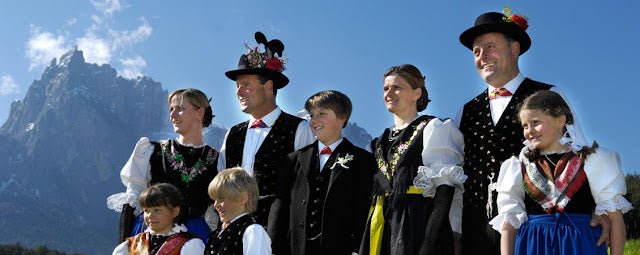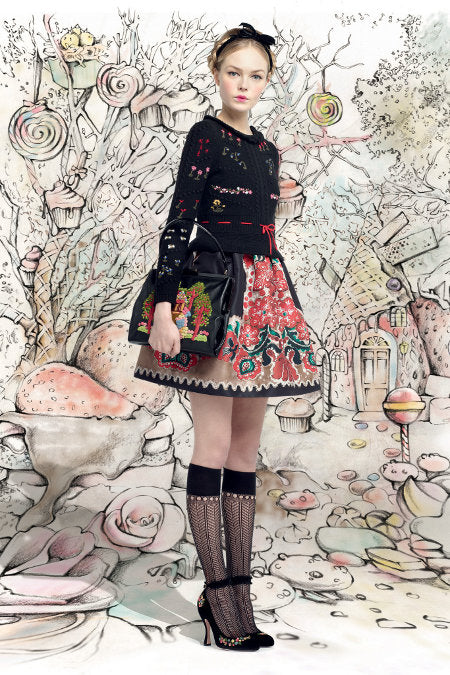
The Art of Tyrolean Knitting: Tradition, Technique, and a Dash of Alpine Magic
Share
Warm greetings, fellow knitters! Today, we embark on a journey to explore the charming world of Tyrolean knitting—a traditional craft that captures the essence of Tyrol and its rich cultural heritage. Get ready to unravel the secrets of this iconic style as we delve into the history, techniques, and unique characteristics that make Tyrolean knitting truly special.
 1940s Tyrolean Knitting Pattern
1940s Tyrolean Knitting PatternThe knitting of Tyrol has a rich and storied history, woven into the fabric of Tyrolean culture. From its humble beginnings as a practical necessity to its status as an art form, Tyrolean knitting represents the creativity, resilience, and enduring traditions of the region.
The Origins and History of Tyrolean Knitting
Picture yourself nestled in a cozy cabin, surrounded by a breathtaking landscape of the Austrian Alps, with its snow-capped peaks and picturesque villages. Tyrolean knitting finds its roots in this mountainous region, where the art of knitting was not just a practical skill but also a means of creative expression. The craft developed as a way for the people of Tyrol to stay warm in the harsh winters while showcasing their artistic talents.
The history of Tyrolean knitting dates back to the early 19th century, when knitting became an integral part of rural Tyrolean life. As the 19th century progressed, the craft expanded beyond the confines of rural life. The growing tourism industry in Tyrol brought the beauty of the local knits to the attention of visitors from around the world. Entrepreneurs recognized the market potential and began commercializing Tyrolean knitting, making it accessible to a wider audience.
 1930s Tyrolean Sweater Patterns
1930s Tyrolean Sweater PatternsIn the early days, knitting was primarily done by women, who skillfully transformed wool from their own sheep into garments for their families. In Tyrol, a region renowned for its rich textile traditions, several breeds of sheep have been historically raised to provide the wool used in Tyrolean knitting. The most common are the Tiroler Bergschaf, Tiroler Steinschaf, and the Tiroler Pustertaler Spinzen. The unique characteristics of their wool, from warmth to texture, have contributed to the distinctive qualities of the region’s knitted garments.
Just like the materials used in Tyrolean knitting, the patterns and techniques were deeply rooted in local traditions, reflecting the culture, beliefs, and daily life of the region. Each village or valley had its own distinct knitting patterns and motifs, serving as a form of identification and pride. These patterns often incorporated symbols from nature, such as flowers, animals, or geometric shapes, carrying hidden meanings and stories within the stitches.
Symbolism in Tyrolean Knitting
Tyrolean knitting is steeped in symbolism, with patterns and motifs carrying deeper meanings for the maker and wearer. Here are some common symbols found in Tyrolean knitting:
 Edelweiss Floral Embroidery
Edelweiss Floral Embroidery Edelweiss: The Edelweiss flower is a cherished symbol of the Tyrolean Alps. The Edelweiss motif represents bravery, strength, and the rugged beauty of the alpine landscape. It is often incorporated into garments as a central motif or as a repeating pattern.
Alpine Animals:
Tyrolean knitting frequently features motifs of alpine animals, such as deer, ibex, or chamois.These animals symbolize the wild and untamed spirit of the mountains, representing agility, grace, and harmony with nature.
Geometric Shapes:
Geometric patterns are common in Tyrolean knitting and can carry various meanings. Diamonds, for example, symbolize wealth, prosperity, and the unbreakable bond of family. Zigzag patterns represent lightning bolts, symbolizing protection from harm and warding off evil spirits. Stars, a common motif, represent guidance, hope, and the guiding light in the dark mountain nights.
Alphorns and Musical Instruments:
Tyrol has a rich musical tradition, and knitting patterns often incorporate motifs of musical instruments, such as the alphorn. Alphorns are traditional wooden horns played in the Alps, and their presence in knitting symbolizes the joy, harmony, and cultural heritage of the Tyrolean people.
Crosses and Religious Symbols: Tyrolean knitting patterns occasionally feature crosses or other religious symbols. These symbols reflect the deep religious beliefs and traditions of the region, representing faith, protection, and blessings.
Family and Heritage: Many Tyrolean designs showcase motifs that symbolize family and lineage. These motifs may include initials, family crests, or motifs that represent ancestral connections, emphasizing the importance of heritage and the bonds between generations.
It's worth noting that while certain design elements may have traditional interpretations, the symbolism in Tyrolean knitting can also vary among different regions, families, or individual knitters. Each pattern and motif carries a unique story, making this a deeply personal and meaningful craft. By incorporating these symbols into their garments, Tyrolean knitters not only create beautiful pieces of clothing but also celebrate the cultural identity, history, and traditions of the region.
Tyrolean Knitting Techniques:
Tyrolean knitting is also renowned for several techniques which contribute to its distinctive look and texture. Here are some notable techniques:
 Twisted Stitch Cables
Twisted Stitch CablesTwisted Stitch Method:
This stitch, also known as the Austrian or Tyrolean twisted stitch, is a defining technique. Instead of knitting through the front loop of the stitch, knitters insert the needle into the back loop, resulting in a twisted stitch.This creates a dense and textured fabric with excellent stitch definition, adding depth and richness to the knitted fabric.
Cable Knitting:
Cables can range from simple twists to complex designs, adding depth, texture, and a touch of elegance to Tyrolean knits.
Colorwork:
Tyrolean knitting often incorporates colorwork. Both Fair Isle and intarsia techniques are employed to showcase contrasting hues, creating vibrant and visually striking designs.
Lace Knitting:
While not as prevalent as twisted stitches and cables, lace knitting can also be found in some Tyrolean patterns. Lace motifs often feature delicate and geometric designs, adding an airy and feminine touch to the garments.
Embroidery and Appliqué:
In addition to the knitting techniques, Tyrolean garments characteristically feature embellishments like embroidery and appliqué, adding decorative motifs and small details to the knitted fabric.
 1980s Tyrolean Sweater
1980s Tyrolean SweaterThese techniques, combined with the use of traditional patterns and motifs, contribute to the charm of Tyrolean knitting. They showcase the skill and artistry of Tyrolean knitters, resulting in garments that are not only warm and practical but also true works of art.
Modern Tyrolean Knitting:
Tyrolean knitwear is immediately recognizable and has been popular since its inception, but the 1940s and 1980s in particular saw many garments in this style, each informed by design characteristics specific to the period. In the 2010s several major fashion brands, from Chanel to Valentino, drew heavily on Tyrolean style for their collections.

The tradition continues today with knitters faithfully recreating garments from vintage patterns and designers reinterpreting the look through a modern lens. The Vienna-based designer Susanne Bisovsky, for example, creates stunning garments inspired by traditional Austrian clothing. Her book Wiener Chic is a feast for the eyes… highly recommended!
In recent years, there has been a huge resurgence of interest in traditional crafts and a renewed appreciation for Tyrolean knitting. Artisans, designers, and knitting enthusiasts have embraced the style, infusing it with contemporary elements and innovative twists. Today, Tyrolean knitting continues to evolve, blending the old with the new, and preserving its cultural significance while captivating a new generation of knitters.


1 comment
Very in-depth and informative. Should be an inspiring starter for “going Tyrolean” with a next project!